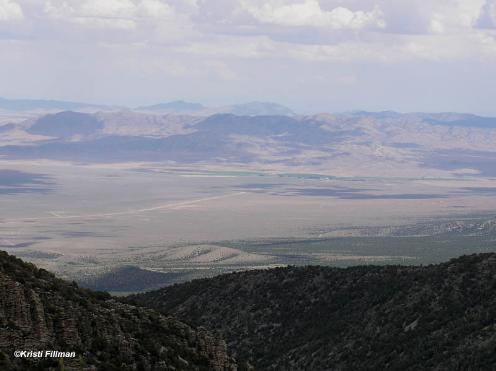The Role of the Snake Valley for Isaac and Family
The Snake Valley, named after the Snake Indians, is 100 miles long and 16 miles wide and runs northeast to southwest, from Millard County, Utah across the state border into White Pine County, Nevada. To the west are the Snake Mountains, which in the south rise to Wheeler Peak (3 982 m) in the Great Basin National Park. In the east, the Confusion Range and Conger Range form valley walls. Snake Valley has plentiful water supplies and hot springs but also salt marshes. The valley around Garrison, south of Gandy and the same latitude as Wheeler Peak, is very green, irrigated with the water from Pruess Lake on the Nevada-Utah border south of Garrison, Utah and north of Burbank, Utah. To the west is the Snake Mountain Range, home of the Great Basin National Park.
The primary value of the lake is providing irrigation to farmers downstream in the Snake Valley. As you drive across the vast Snake Valley, you will see patches of green where farmers have utlilized water from the many streams that flow from the Snake Range.
In 1855 Brigham Young sent a group of elders to establish a mission and plant crops in “Grease Wood Valley”, the original name for Snake Valley.

Lehman Caves
The Lehman Caves in the Snake Valley (now part of the Great Basin National Park) and noted for remarkable stalactites and stalagmites, were discovered in 1885 by Absalom S. Lehman. There are said to be at least 40 accounts of how they were discovered. Many accounts agree that the first party of people to enter the cave included most of Snake Valley’s early citizens. These include Ab and Ben Lehman, William Burbank, Dan Simonsen, E.W. Clay, Ed Lake, William Atkinson, Isaac Gandy, George Robinson, D.A. Gonder, P.M. Baker and Nettie baker, who was probably the first white woman to see the cave. (NPS)
See a modern map of the Snake Valley and Gandy here
Garrison
“Close to the Nevada border,….several adobe and log cabins mark the site of an outlaw camp that later became a farm town and still later a ghost town. Garrison had its birth as an outlaw ranch. There, Utah cattle were fattened up before being driven across the Nevada border, where buyers asked no embarrassing questions about the variety of brands in the herd. It remained an outlaw hideout until Mormon settlers began moving into Snake Valley and settled nearby Burbank. In time the new arrivals crowded out the criminals. As they left, Garrison began looking like a town with a future. A post office was established, named Garrison for one of the settlers, and a general store opened by “James & Clay” became a favourite meeting place for valley farmers.”
Excerpt from “Some Dreams Die” by George A Thompson, Dream Garden Press, Salt Lake City 1982 and 1999.
Link to map of Garrison and Isaac’s grave. More about Millard County.
The Beauty of the Snake Valley

Tony Cowley has contributed many photographs to the website and is a frequent visitor and hiker in the Snake Valley and Wheeler Peak National Park. Tony says: My great grandparents on my father’s side, from England, have been here since 1864. I am not directly related to Peter Robison but my first-cousin’s father was Henry Robison from Hatton (earlier Petersburg). My father’s sister married Henry. There are many, many Robisons around Fillmore. I am on the city council here in Meadow, and one other councilman is Lloyd Robison, a descendant of Peter’s brother Joseph. One of my duties here in Meadow is to supervise the care of the cemetery where I even have a great great grandmother buried, from England. Utah was at one time 65% of British origin, and the 30% remainder was Scandinavian, with 5% being other. It shows heavily today.
Tony describes his impressions of the Snake Valley here:
See Tony’s photographs of Stella Lake (named after Estella Gandy, youngst daughter of Isaac and Harriet) and Wheeler Peake here:
Protect Snake Valley
Read more here about the organisation which has been formed to protect the Snake Valley from the attempts to channel the water in the Snake Valley to other areas and for irrigation purposes (the water issue in the Great Basin). You can also read there about the annual Snake Valley Festival organised to have fun and raise awareness of the water issue.